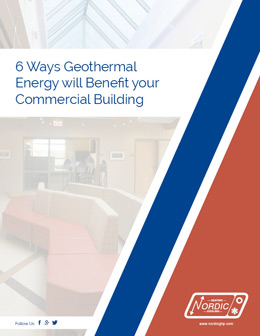Incorporating a commercial geothermal heat pump into a large building is becoming an increasingly popular option, and it’s easy to see why. Geothermal heat pumps are eco friendly, they provide a comfortable, reliable heat and the economic benefits mean your building will have low operating costs for decades.
How A Geothermal Heat Pumps Work in Large Buildings
A commercial geothermal heat pump operates on a simple principle: it moves heat from one place to another via a refrigeration process. In a commercial building, a series of heat pumps removes heat from an energy supply source in the ground. The heat pump concentrates this low-grade heat, raising its temperature and then transfers it to the building’s energy distribution system (usually radiant in-floor and hydronic fan coils) via a heat exchanger. In the summer, the process is reversed. The heat pumps collect heat from the building and deposit it into the ground loop, providing cooling.
Commercial Geothermal Heat Pumps Work in Any Large Building
Our commercial heat pumps have been installed in a variety of applications including schools, nursing homes, police stations and farmers’ markets. Many of these buildings are LEED certified and valued in the millions of dollars. Over the past several decades as commercial heat pump installations have become more popular and thus more standardized, a generally accepted typical implementation has emerged for commercial installations.
A commercial geothermal heat pump needs a collector system, just like a water well pump. You could set a water pump on your desk and turn it on, but it won’t pump water unless it is connected to a source. In your geothermal system’s case, the source is a vertical borehole loop field that is located under a parking lot or recreational field. The heat is removed from the loop field and transferred to the building via a series of Nordic® Commercial W Series heat pumps.
Finally, the heating is delivered via large-scale radiant in-floor heating, and cooling is delivered via hydronic fan coils. The design of the ground loop and distribution system, and the number of size of heat pumps can be modified depending on your specific building’s footprint and layout so that commercial geothermal will work in any commercial building.
The Nordic® Commercial W Series is the Right Choice
The Nordic® Commercial W Series is our top selling commercial geothermal heat pump. This unit is available in a wide variety of sizes, allowing them to be configured to precisely suit the needs of your building. We work closely with system designers to help create a heating and cooling system that will maintain optimum comfort, achieve low operating costs, and require little maintenance. Here is an overview of our newly redesigned Commercial W Series.
Geothermal heat pumps are highly efficient. In fact, they are the most efficient heating and cooling equipment on the market today. This is because they simply move heat from place to place, instead of generating it from a fuel source like oil, natural gas or electricity. For example, for every watt of electricity you buy, electric heating systems generate 1 watt of heat. Geothermal heat pumps, on the other hand, move 4.1 watts of heat energy into your building for every watt of electricity used. This means geothermal heat pumps have a coefficient of performance (COP) of 4.1, compared to electricity, which has a COP of 1. This efficiency will allow you to save huge amounts on your monthly utility costs.

vs

Double Your Efficiency With Simultaneous Heating and Cooling
Simultaneous heating and cooling is a method for you to effectively double your COP from 4.1 to 8.2. This will lower your operating costs even more. We accomplish this remarkable efficiency by taking advantage of both sides of a heat pump. Here’s how it works:
Multiple heat pumps are connected in parallel between hot and cold buffer tanks. The hot buffer tank connects to the heating zones and the hot side of the heat pumps. The cold buffer tank connects to the cooling zones and the cold side of the heat pump. Whenever the system is in operation the heat pumps absorb heat from the cold buffer tank and reject this heat along with compressor energy to the hot buffer tank. Energy is replaced in the cold buffer tank as the water is warmed by the cooling operation and conversely energy is removed from the hot buffer tank by the heating operation.
If the heating and cooling loads are balanced then the system does not require the ground loop to add or take away energy. However, most of the time there will be an imbalance in the heating/cooling loads and under these conditions the system circulating fluid will be routed to the ground loop field to absorb or reject energy as required to balance the system.
Because there is both a hot and cold buffer tank, this system allows both heating and cooling to take place at the same time. Thus, for example, one two ton heat pump can simultaneously provide two tons of cooling and two tons of heating for a total of four tons while the building owner only pays the cost of one two ton unit operating. This is ideal if your building requires heating in certain parts of the building (for example the north side) and cooling in other parts (such as the south side). This configuration virtually doubles the efficiency of the system compared to a conventional reversing heat pump system because both sides of the heat pump provide economic usefulness to the building.


